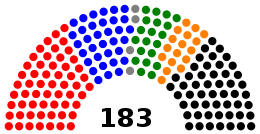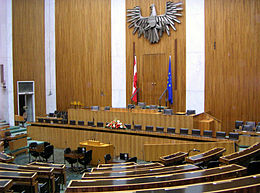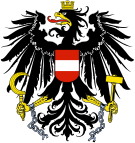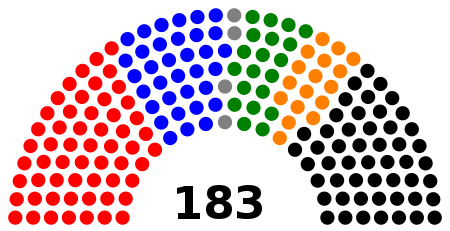- National Council of Austria
-
National Council of Austria
Nationalrat24th Legislative Period 
Type Type Lower house Leadership President Barbara Prammer, SPÖ
since 30 October 2006Second President Fritz Neugebauer, ÖVP Third President Martin Graf, FPÖ Structure Members 183 
Nationalrat Political groups Elections Nationalrat Voting system Proportional representation Nationalrat Last election 28 September 2008 Meeting place 
Parlament
Innere Stadt, Vienna
Republic of AustriaWebsite Official Website The National Council (German: Nationalrat) is one of the two houses of the Austrian parliament. According to the constitution, the National Council and the complementary Federal Council are peers. As a practical matter, the National Council is decidedly more powerful, though it is frequently described as the lower house.
Contents
Responsibilities
Austria 
This article is part of the series:
Politics and government of
AustriaConstitutionExecutive- President (List)
- Federal Government
- Chancellor (List)
- Vice-Chancellor
- Cabinet
Parliament- Parliament/Federal Assembly
- National Council
- Federal Council
- Political parties
Decentralized gov'tForeign policy
The National Council is where Austria's federal legislative authority is concentrated; for a bill to become federal law, it must be resolved upon by this chamber. Bills passed by the National Council are sent to the Federal Council for corroboration. If the Federal Council approves of the bill or simply does nothing for eight weeks, the bill has succeeded. If the Federal Council vetoes the bill, the National Council may still force it into law by essentially just passing it again; a National Council resolution overruling a Federal Council objection merely has to meet a higher quorum than a regular resolution. In other words, the Federal Council does not have any real power to prevent adoption of legislation, the National Council being trivially able to override it. There are three exceptions to this rule: bills amending constitutional law, bills curtailing the rights of Austria's member states, and bills pertaining to the organization of the legislature itself cannot be forced into law against Federal Council opposition.
The approval of the National Council is also required for most of the prerogatives of the Federal Assembly to be exercised. For example, motions to call for a referendum aimed at having the President removed from office by the electorate, and motions to declare war all need a two-thirds majority in the National Council. Only motions to impeach the President can also be from the Federal Council.[1]
Elections
The 183 members of the National Council are elected by nation-wide popular vote for a term of four years; each Austrian sixteen years or older on the day the election takes place is entitled to one vote. National Council elections are general elections. The voting system aims at party-list proportional representation, uses partially open lists, and is relatively straightforward:
- For the purpose of National Council elections, Austria is divided into nine regional electoral districts corresponding to the nine states of Austria. The nine regional electoral districts are subdivided into a total of 43 local electoral districts. Political parties submit separate ranked lists of candidates for each district, regional or local, in which they have chosen to run. They also submit a federal-level list.
- Votes cast are first counted within their local electoral districts. Since there are 43 local districts but 183 seats to fill, local districts will typically have more than one seat assigned to them. The number of seats assigned to each local district is based solely on electoral district population, as established by the most recent census; the partitioning and apportionment rules are simple enough to prevent gerrymandering from becoming an issue. The number of votes required to win one seat is simply the number of votes divided by the number of seats assigned to the district in question. For example, if 150,000 votes are cast in your five-seat local district, 30,000 votes win one seat. If your party has scored 61,000 votes out of the 150,000 votes cast, your party is entitled to two seats, to be taken by the first two candidates on your party's local district list. Since 60,000 votes would have been sufficient to win two seats, 1000 votes are left unaccounted for by this first round of tallying.
- Any vote not accounted for on the local level is dealt with on the regional level, provided that the party it has been cast for has obtained at least four percent of the regional total vote. The system is analogous to that used on the district level; the number of seats assigned to a regional district is simply the number of seats assigned to one of its constituent local districts but not filled during the first round of tallying.
- Any vote not accounted for on the regional level either is dealt with on the federal level, provided that the party it has been cast for has obtained at least four percent of the federal total vote. The D'Hondt method is used to allocate any National Council seats remaining to be filled.
In addition to voting for a party list, voters may express preference for one individual candidate. A candidate receiving sufficiently many personal votes can rise in rank on his or her district party list; voters thus have a certain degree of influence as to which particular individual wins which particular seat. It is not possible, however, to simultaneously vote for party X but exert influence on the candidate rankings on the party list of party Y.
Peculiarities
Austria's federal constitution defines Austria to be a presidential democracy: the executive branch of government is supposed to be headed by the president and not to be answerable to the legislative branch. In practice, however, Austria's federal administration as such has comparatively little scope and would be almost totally paralyzed should the National Council fail to support it. While the executive branch has the theoretical authority to dissolve a hostile National Council, constitutional convention prevents this power from being exercised. Austria accordingly functions as a parliamentary democracy: for all intents and purposes, the cabinet is subject to approval by the National Council, the president being little more than a figurehead.
A related discrepancy between Austrian constitutional theory and Austrian political practice is that the constitution defines the President of the National Council to be Austria's second highest public official, junior only to the president proper. As a practical matter, the President of the National Council is a representative of rather moderate significance: wielding less power than the president by extension means wielding less power than the head of cabinet or even most federal ministers. The President of the National Council thus serves mostly as a more or less nonpartisan moderator of parliamentary debate.
Latest election
Summary of the 28 September 2008 National Council of Austria election results Parties Votes +/− % +/− Seats +/− Social Democratic Party of Austria (Sozialdemokratische Partei Österreichs) 1,430,206 −233,780 29.26 −6.08 57 −11 Austrian People's Party (Österreichische Volkspartei) 1,269,656 −346,837 25.98 −8.35 51 −15 Freedom Party of Austria (Freiheitliche Partei Österreichs) 857,029 +337,431 17.54 +6.50 34 +13 BZÖ – Jörg Haider's List (BZÖ – Liste Jörg Haider) 522,933 +329,394 10.70 +6.59 21 +14 The Greens – The Green Alternative (Die Grünen – Die Grüne Alternative) 509,936 −10,194 10.43 −0.62 20 −1 Liberal Forum (Liberales Forum) 102,249 * 2.09 * 0 –1 ¶ Citizens' Forum Austria Fritz Dinkhauser's List (Bürgerforum Österreich Liste Fritz Dinkhauser) 86,194 * 1.76 * 0 * Communist Party of Austria (Kommunistische Partei Österreichs) 37,362 −10,216 0.76 −0.25 0 — Independent Citizens' Initiative Save Austria (Unabhängige Bürgerinitiative Rettet Österreich) 35,718 * 0.73 * 0 * The Christians (Die Christen) 31,080 * 0.64 * 0 * Animal Rights Party earth–human–animals–nature (Tierrechtspartei earth–human–animals–nature) [2] 2,224 * 0.05 * 0 * Left (Linke) [1] 2,138 –119† 0.04 ;±0.00† 0 † Dipl.-Ing. Karlheinz Klement (Dipl.-Ing. Karlheinz Klement) [3] 347 * 0.01 * 0 * List Strong (Liste Stark) [3] 237 −75 0.00 –0.01 0 — Invalid/blank votes 103,643 — — — — — Total (turnout 78.82%; +0.34%) 4,990,952 — 100.0 — 183 — Notes: - * Did not contest the 2006 election.
- ¶ Did not contest the 2006 election on its own, but won a seat on the SPÖ's list.
- [1] Contested the election only in Burgenland, Salzburg, Tyrol, Upper Austria and Vienna.
- † Compared to the Socialist Left Party, which contested the 2006 election and was part of the Left in 2008 election.
- [2] Contested the election only in Vienna.
- [3] Contested the election only in Carinthia.
Source: Nohlen D & Stöver P (2010) Elections in Europe: A data handbook p217 Make-up of the National Council
Party Members SPÖ 57 ÖVP 51 FPÖ 34 Grüne 20 BZÖ 17 FPK 3 Independent 1 Total 183
Elections
 Elections and referendums in AustriaAs Cisleithania (1848–1918)
Elections and referendums in AustriaAs Cisleithania (1848–1918)Imperial Council elections Independent Austria (1918–present)Parliamentary elections Presidential elections European elections Referendums 1938 · 1978 · 1994See also
- List of Presidents of the National Council of Austria
References
- ^ Federal Assembly - Responsibilities and Legal Principles, retrieved 18 May 2010
External links
- Official website
- National Council Elections Statute, official rules and regulations (in German)
Categories:- National lower houses
- Politics of Austria
- Parliament of Austria
Wikimedia Foundation. 2010.

